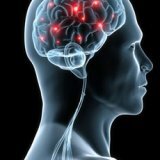Infectious diseases of the nervous system
 One of the most extensive sections of neurology is infectious diseases of the nervous system. All of them are first of all subdivided into viral and bacterial groups. There is some classification that describes some possible ways of infection. This may be a consequence of a violation of the integrity of the hard shell of the brain or spinal cord due to injury. Some ENT diseases, leading to complications on the intracranial or intraspinal level. Complications caused by improper conduction of an intra-vertebral puncture or epidural anesthesia. Although some diseases can be obtained by banal airborne droplets, for example, meningitis is transmitted. Infectious diseases are widely represented, there are a huge number of them with different symptoms and the nature of the course of the disease.
One of the most extensive sections of neurology is infectious diseases of the nervous system. All of them are first of all subdivided into viral and bacterial groups. There is some classification that describes some possible ways of infection. This may be a consequence of a violation of the integrity of the hard shell of the brain or spinal cord due to injury. Some ENT diseases, leading to complications on the intracranial or intraspinal level. Complications caused by improper conduction of an intra-vertebral puncture or epidural anesthesia. Although some diseases can be obtained by banal airborne droplets, for example, meningitis is transmitted. Infectious diseases are widely represented, there are a huge number of them with different symptoms and the nature of the course of the disease.
Types of diseases of the nervous system of infectious nature
The most striking representative of this kind of diseases is meningitis. It is an inflammatory process that affects the brain and spinal cord. Meningitis is very common throughout the globe. The causative agents of this disease of the nervous system can be both protozoa and bacteria, and viruses. So after a virus flu, as a complication, meningitis can occur. In turn, meningitis by the nature of the inflammatory process and changes occurring in the cerebrospinal fluid is divided into purulent and serous. The pathogenesis of meningitis is divided into primary and secondary. On the bacterial etiology of a meningitis there are: meningococcal, pneumococcal, staphylococcal, tubercular. And according to the virus etiology it is: acute lymphocytic choriomeningitis, which appears due to the presence of certain enteroviruses, fungal and others. Meningitis often happens even in newborn children and it is caused by streptococci in a certain group. Meningitis also has several stages of its development, such as fulminant, acute, subacute and chronic. This applies to the degree of its severity, ranging from mild, moderate, severe and ending with a particularly severe form. Meningitis is a very terrible and rapidly developing disease. Therefore, the earlier the diagnosis is made and the etiology is determined, the faster and more efficient it will be possible to select a treatment.
To the most pronounced symptoms of the disease include:
- unbearable headache, a sharp rise in temperature, often accompanied by indomitable vomiting;
- syncope, or vice versa increased excitability, convulsions, stiff neck muscles, disorders in the musculoskeletal system;
- violation of the main reflexes.
With a lubricated pattern of symptoms, lumbar puncture is recommended.
Patients with meningitis should preferably be examined in a hospital and do not try to self-medicate, otherwise each lost minute or hour can be very important for life.
No less dangerous and common infectious disease of the nervous system is encephalitis. In the medical encyclopedia it appears that encephalitis is an inflammation of the human brain. This disease also has its numerous classification depending on the causes of origin, spread, etiology and much more. According to the main classifications, encephalitis, depending on its location, can be hemispheric, stem, cerebellar, mesencephalic, diencephalic. The main feature of the disease is that sometimes, in addition to the substance of the brain, some parts of the spinal cord are also affected. According to the area of damage, encephalitis is divided into focal and diffuse, and purulent and non-purulent encephalitis are subdivided according to the nature of the exudate. Clinical manifestations of encephalitis are different and largely depend on the pathogen, the course of the disease and the localization of the pathological process.
But the characteristic clinical symptoms remain:
- gradual temperature rise for several days, upper respiratory tract damage and gastrointestinal disorders( apparent similarity with acute respiratory infections or respiratory viral diseases);
- increasing headache, vomiting, acute pain in the eye sockets, photophobia, possible epileptic seizures, convulsions, fainting, breathing disorders;
- in advanced stages of paresis of upper or lower extremities.
Encephalitis is a disease that requires urgent diagnosis. And almost not treated at home, because it requires the implementation of procedures for purely professional medical intervention. Lightning encephalitis develops from several hours to several days. In case of incorrect diagnosis or conscious refusal of conservative treatment in a hospital, a lethal outcome is inevitable. Therefore, before letting the course of the disease or engaging in its self-medication, consider what this attitude towards yourself and your relatives is fraught with.
Treatment of encephalitis is a long-term, but effective, process that includes pathogenetic and etiotropic therapy, various symptomatic remedies, and various restorative measures. The basis of treatment is dehydration, in order to minimize the swelling and edema of the brain. Hormone therapy, procedures to eliminate cardiovascular disorders, and, of course, anti-inflammatory therapy with mandatory inclusion of strong antibiotics. Depending on the complications obtained, medications are also prescribed for normalizing sleep, improving brain metabolism, drugs that improve and normalize consciousness. After the complex treatment is recommended to go through a rehabilitation course, with a view to the final restoration and consolidation of the affected functions of the body.
Remember always that careless attitude to yourself, your health and the health of family and friends often leads to irreparable consequences. And every possible preventive actions and procedures will allow you to always remain in full health.



